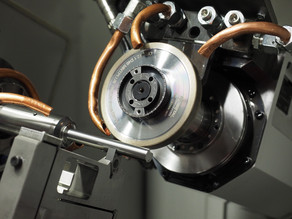SPP 2231 FLUSIMPRO: Fully coupled fluidstructure-contact simulations to understand the processes in the contact zones during lubricatedorthogonal cutting
During the machining of metallic materials, high temperatures and contact pressures occur in the contact zones, which initiate and significantly influence various friction mechanisms. In the course of the process, these conditions lead to tool wear and a reduction in component quality. A commonly applied method to influence the contact situation towards lower stresses and temperatures is the use of cooling lubricants, which have the primary tasks of reducing friction, dissipating heat and removing chips from the contact zone. The mechanisms involved are mostly unexplored, so that the controlled application and predictability of the effect of cooling lubricants through simulation programs are only possible to a limited extent today. The aim of this project is to gain a deeper understanding of the mechanisms in the secondary shear zone when using cooling lubricants in orthogonal cutting and subsequently to develop a numerical methodology for predicting the effect of cooling lubricants in the contact zone by a tribological CFD simulation. In order to achieve this goal, the contact situation is characterized in various experimental test series at the Institute of Machining Technology at TU Dortmund University using differently prepared tool surfaces. In addition to the characterization of the surface topographies, the wetting behaviour is also investigated. In addition, an equivalence test rig for friction characterization will be used to gain initial insights into the friction mechanisms between carbide bodies and C45 or Ti6Al4V when cooling lubricants are used. Based on the results, a numerical tribological model will be developed at the Institute of Lightweight Design and Structural Biomechanics at TU Wien, which will map the behavior of the friction partners in contact and the coolant lubricant to the micro level. The focus here is on the development of a fully coupled fluid-structure contact simulation for the application in orthogonal cutting. Core elements of the numerical method are spline-based finite element methods as well as boundary-conform computational gratings using space-time discretization. At the end of the first funding period, friction coefficients will be generated from the tribological CFD simulation and applied in FEM chip formation simulation as a first validation. Within the experimental test series, it is planned to generate information regarding wetting and temperatures in the secondary shear zone in addition to the mechanical tool loads with based on a partially and temporarily interrupted cut and to compare this information with the simulation results.
In first investigations using a friction characterization test rig under conditions similar to cutting, it was found that wetting the cemented carbide surface with an oil-based cooling lubricant has a significant influence on the friction coefficient of the tribological system consisting of workpiece material and cemented carbide. In parallel, the tribological IGA simulation is being developed, for which differently prepared cemented carbide surfaces have already been characterized as input variables.





![[Translate to English:] [Translate to English:]](/storages/isf-mb/_processed_/a/1/csm_Wendel_Tiefbohrer_51a08eea1c.jpg)